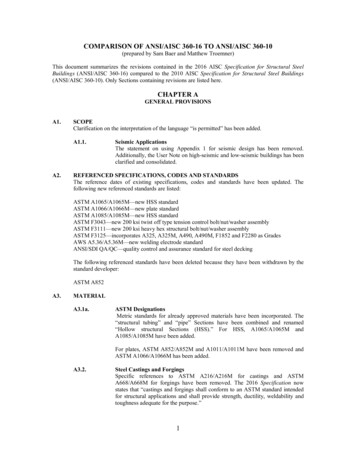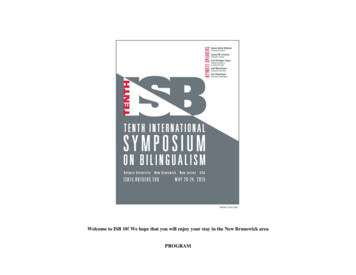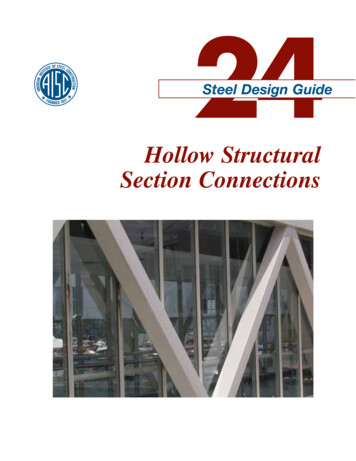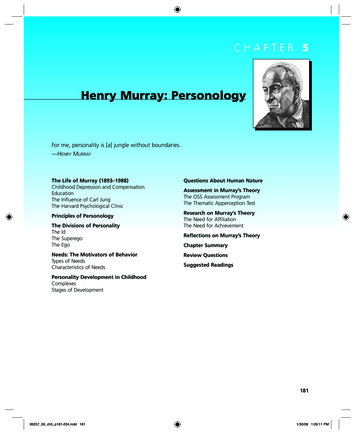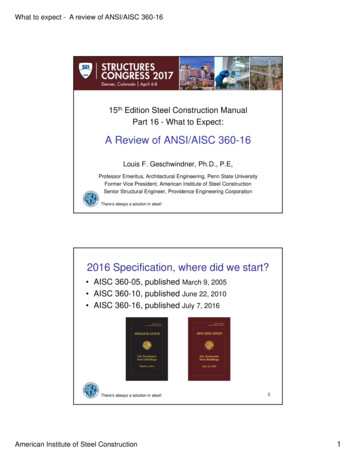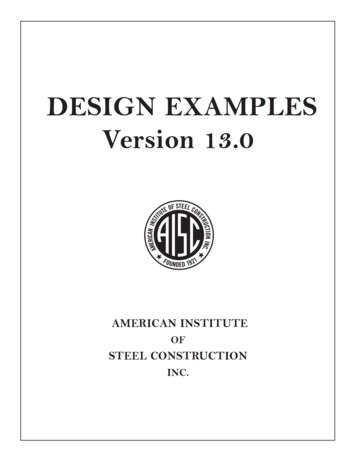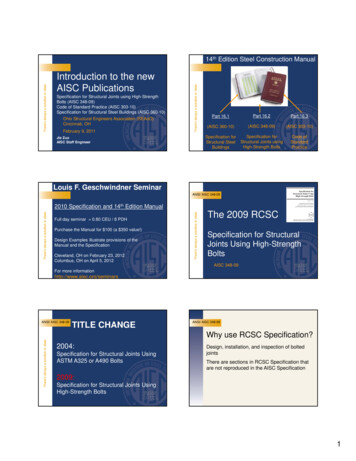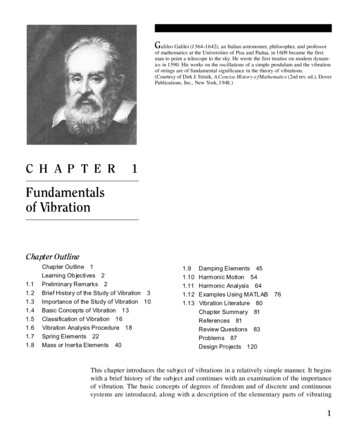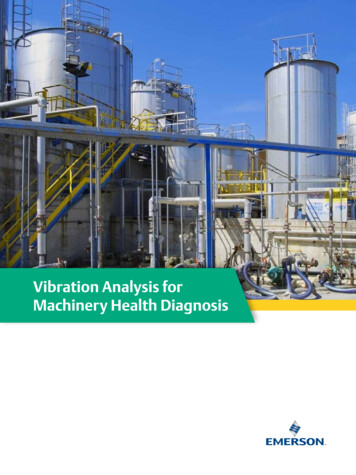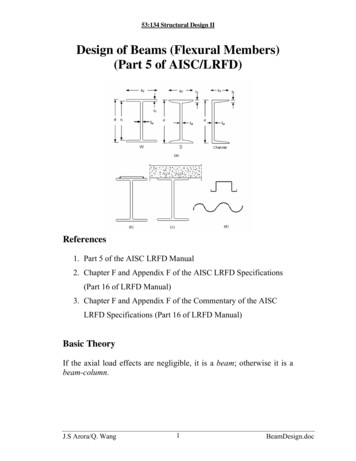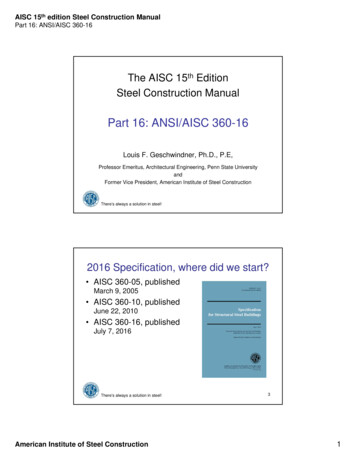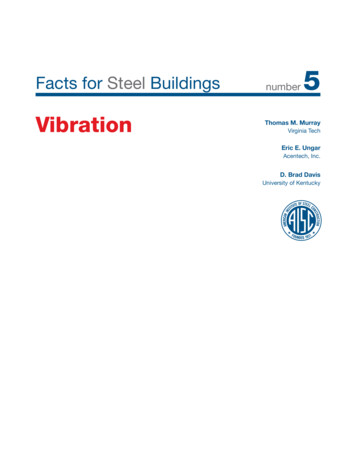
Transcription
Facts for Steel BuildingsVibrationnumber5Thomas M. MurrayVirginia TechEric E. UngarAcentech, Inc.D. Brad DavisUniversity of Kentucky
AISC 2018byAmerican Institute of Steel ConstructionAll rights reserved. This book or any part thereof must not be reproducedin any form without the written permission of the publisher.The AISC logo is a registered trademark of AISC.The information presented in this publication has been prepared following recognized principles of design andconstruction. While it is believed to be accurate, this information should not be used or relied upon for any specificapplication without competent professional examination and verification of its accuracy, suitability and applicabilityby a licensed engineer or architect. The publication of this information is not a representation or warranty on thepart of the American Institute of Steel Construction, its officers, agents, employees or committee members, or ofany other person named herein, that this information is suitable for any general or particular use, or of freedom frominfringement of any patent or patents. All representations or warranties, express or implied, other than as stated above,are specifically disclaimed. Anyone making use of the information presented in this publication assumes all liabilityarising from such use.Caution must be exercised when relying upon standards and guidelines developed by other bodies and incorporated byreference herein since such material may be modified or amended from time to time subsequent to the printing of thisedition. The American Institute of Steel Construction bears no responsibility for such material other than to refer to itand incorporate it by reference at the time of the initial publication of this edition.Printed in the United States of America
AuthorsThomas M. Murray, Ph.D., P.E., is an Emeritus Professor of Structural Steel Design, Department of Civil and EnvironmentalEngineering, Virginia Tech, Blacksburg, VA. He is a member of the AISC Committee on Specifications and its task committeeConnection Design. He is also a member of the AISC Committee on Manuals.Eric E. Ungar, Sc.D., P.E., is Chief Engineering Scientist, Acentech Incorporated, Cambridge, MA.D. Brad Davis, Ph.D., S.E., is an Associate Professor, Department of Civil Engineering, University of Kentucky, Lexington, KY.He is a member of the AISC Committee on Manuals.AcknowledgmentsThe authors thank the American Institute of Steel Construction for funding the development of this document and for assistancein its preparation. The authors also wish to thank the following reviewers and staff members whose contributions significantlyimproved the document. Their contributions are gratefully acknowledged.Allen AdamsOnur AvciAnthony BarrettCynthia DuncanLanny FlynnLouis GeschwindnerChristopher HewittStephen HicksWill JacobsDi LiuMargaret MatthewRonald MengDan MullinsDavis ParsonsAhmad RahimianDavid SamuelsonAndres SanchezTom SchlaflyWalt SchultzWilliam ScottWilliam SeguiVictor ShneurMark WaggonerRon YeageriiiAISC 2018 Fact-5 Vibration 01FM.indd 312/6/18 4:36 PM
ivAISC 2018 Fact-5 Vibration 01FM.indd 412/6/18 4:36 PM
Table of ContentsSECTION 1. INTRODUCTION . . . . . . . . . . . . . . . . . . 13.123.13SECTION 2. GENERAL TOPICS . . . . . . . . . . . . . . . . 32.12.22.32.42.52.62.72.82.9Why is vibration of steel-framed structuralsystems supporting human activity aserviceability issue? . . . . . . . . . . . . . . . . . . . . 3What types of steel-framed systemsshould be considered for vibrationserviceability evaluation? . . . . . . . . . . . . . . . . . 3What is resonance? . . . . . . . . . . . . . . . . . . . . . 3What is the major cause of annoying vibrationsbecause of human activity? . . . . . . . . . . . . . . . 3What are the major causes of complaintsbecause of human activity? . . . . . . . . . . . . . . . 3What are some myths versus reality aboutfloor vibrations? . . . . . . . . . . . . . . . . . . . . . . 3Which is better, a hot-rolled beam or anopen-web steel-joist-supported floor? . . . . . . . . . 4What do architects need to consider with respectto vibration? . . . . . . . . . . . . . . . . . . . . . . . . . 4What are the differences among the analysisprocedures for evaluating walking-caused vibrationin SJI Technical Digest No. 5, the CRSI DesignGuide, the PCI Handbook, the SCI P354 guide, andthe UK Concrete Centre CCIP-016 versus those inAISC Design Guide 11? . . . . . . . . . . . . . . . . . 43.143.153.163.173.183.193.203.213.22SECTION 4. FLOORS FORQUIET OCCUPANCIES . . . . . . . . . . . . . . . . . . 134.14.24.3SECTION 3. SOME BASICS . . . . . . . . . . . . . . . . . . . . 73.13.23.33.43.53.63.73.83.93.103.11How does member continuity affectnatural frequency? . . . . . . . . . . . . . . . . . . . . . 9What is damping?How is damping expressed? . . . . . . . . . . . . . . . 9How does damping affect vibration response? . . . 9What is mode shape? What is modal mass? . . . 10How is the response of a structure due tohuman activity predicted? . . . . . . . . . . . . . . . 10What are the components of forces producedby human activity? . . . . . . . . . . . . . . . . . . . . 10How large is the variation in footstepforcing functions? . . . . . . . . . . . . . . . . . . . . 11How can the walker and affected occupant orequipment be accounted for when they arenot at mid-bay? . . . . . . . . . . . . . . . . . . . . . . 11How does exterior cladding affectfloor response? . . . . . . . . . . . . . . . . . . . . . . 11How do interior dry wall partitions affectfloor response? . . . . . . . . . . . . . . . . . . . . . . 12How are irregular bays analyzed? . . . . . . . . . . 12How does human activity cause structural framingto vibrate? . . . . . . . . . . . . . . . . . . . . . . . . . . 7What is an evaluation criterion?How is human tolerance measured? . . . . . . . . . . 7How is sensitive equipmenttolerance measured? . . . . . . . . . . . . . . . . . . . . 7What are the most important parameters thatmust be considered when evaluating a structuralsystem for vibration serviceability? . . . . . . . . . . 7What is natural frequency, and howis it determined? . . . . . . . . . . . . . . . . . . . . . . 7What is forcing frequency? . . . . . . . . . . . . . . . 8What is a low-frequency floor (LFF)?High-frequency floor (HFF)? . . . . . . . . . . . . . . 8Is there a frequency range where humans aremost sensitive? . . . . . . . . . . . . . . . . . . . . . . . 8What is the contribution of the deck slab to thenatural frequency of floors? . . . . . . . . . . . . . . . 9What effect does composite action have onvibration response? . . . . . . . . . . . . . . . . . . . . .94.44.54.64.74.84.9Is the evaluation criterion for quietoccupancies empirical? . . . . . . . . . . . . . . . . . 13Why does it appear that the walker’s full weightis not used in the evaluation criterion? . . . . . . . 13What typical superimposed loads shouldbe considered? . . . . . . . . . . . . . . . . . . . . . . . 13What is meant by a floor panel, a beam or ajoist panel, and a girder panel? . . . . . . . . . . . . 15How do floor width and floor length affectthe response of floors? . . . . . . . . . . . . . . . . . 15How do I determine floor width andfloor length? . . . . . . . . . . . . . . . . . . . . . . . . 15How are mezzanines (flat rectangularbalconies) analyzed? . . . . . . . . . . . . . . . . . . . 16Why is there a 3-Hz minimum naturalfrequency recommendation for floors? . . . . . . . 16How accurate are the AISC Design Guide 11predictions for floors supportingquiet occupancies? . . . . . . . . . . . . . . . . . . . . 16SECTION 5. FRAMING FOR RHYTHMICACTIVITIES . . . . . . . . . . . . . . . . . . . . . . . . . . . . 175.15.2What is the major cause of high accelerationsfrom rhythmic activities? . . . . . . . . . . . . . . . . 17What limit state is being satisfied by the AISCDesign Guide 11 rhythmic predictions? . . . . . . 17vAISC 2018 Fact-5 Vibration 01FM.indd 512/6/18 4:36 PM
5.35.45.55.65.75.85.95.105.115.12SECTION 7. MONUMENTAL STAIRS . . . . . . . . . . 25What tolerance criterion is used for rhythmicactivities? . . . . . . . . . . . . . . . . . . . . . . . . . . 17Why is there a separate acceleration tolerancelimit when weight lifters are present? . . . . . . . . 17What is the difference between resonant andoff-resonant activity? . . . . . . . . . . . . . . . . . . 17When is it difficult to satisfy the rhythmicexcitation tolerance limit? . . . . . . . . . . . . . . . 17Can spaces designed for offices or retail spacebe used for fitness centers? . . . . . . . . . . . . . . . 18Is it possible to isolate bays supporting rhythmicactivities from surrounding bays? . . . . . . . . . . 18Is flooring that is designed to reduce leg strainhelpful in reducing floor motion? . . . . . . . . . . 18Can checkerboard framing be used toreduce girder size in floors supportingrhythmic activities? . . . . . . . . . . . . . . . . . . . 18What are floating floors andtheir applications? . . . . . . . . . . . . . . . . . . . . 18Have there been problems reportedbecause of fitness centers in lower floorsof tall buildings? . . . . . . . . . . . . . . . . . . . . . 187.17.27.37.47.57.67.7SECTION 8. PEDESTRIAN BRIDGES . . . . . . . . . . 318.18.2SECTION 6. FLOORS FOR SENSITIVEEQUIPMENT . . . . . . . . . . . . . . . . . . . . . . . . . . . 216.16.26.36.46.56.66.76.86.96.106.116.126.13What are monumental stairs, and why arethey vulnerable to annoying human-inducedvibrations? . . . . . . . . . . . . . . . . . . . . . . . . . 25Which causes a more severe dynamic load—stairascent or a stair descent? . . . . . . . . . . . . . . . . 25How are the modal properties of a monumentalstair calculated? . . . . . . . . . . . . . . . . . . . . . . 26How is damping estimated for stairs? . . . . . . . . 27What are the vibration tolerance limits forstationary occupants on a stair? . . . . . . . . . . . . 27How should the effect of walker and affectedoccupant locations be included in the evaluationof a monumental stair? . . . . . . . . . . . . . . . . . 27Are there minimum vertical and lateral naturalfrequency recommendations? . . . . . . . . . . . . . 278.3What is the recommended approach forevaluating bays for sensitive equipment? . . . . . 21What are some common vibrationresponse metrics? . . . . . . . . . . . . . . . . . . . . . 21What do sensitive equipment vibrationtolerance specifications look like? . . . . . . . . . . 21What is meant by generic tolerance limits? . . . . 21What set of generic tolerance limitsis recommended? . . . . . . . . . . . . . . . . . . . . . 21What is the difference among resonant,impulse and intermediate responses? . . . . . . . . 22What is the meaning of the walking speedsgiven in AISC Design Guide 11, Chapter 6? . . . 23How are response predictions adjusted forwalker and sensitive equipment location? . . . . . 23How are generic tolerance limits used toevaluate a floor bay? . . . . . . . . . . . . . . . . . . . 23How are specific tolerance limits used toevaluate a floor bay? . . . . . . . . . . . . . . . . . . . 23What structural parameters affect vibrationresponse? . . . . . . . . . . . . . . . . . . . . . . . . . . 23What nonstructural changes can reducevibration response? . . . . . . . . . . . . . . . . . . . . 23How are patient rooms and operatingrooms evaluated? . . . . . . . . . . . . . . . . . . . . . 238.48.58.6Why is the amplitude of the driving force,Po, different for pedestrian bridges than thatof floors? . . . . . . . . . . . . . . . . . . . . . . . . . . 31How is the acceleration caused by a marchinggroup predicted? . . . . . . . . . . . . . . . . . . . . . 31How is the acceleration caused by randomwalking predicted? . . . . . . . . . . . . . . . . . . . . 31Why is there a 3-Hz minimum natural frequencyrecommended for pedestrian bridges? . . . . . . . . 31Is lateral motion a vibration issue? . . . . . . . . . . 31How do the AASHTO (2009) criteria forassessing vertical pedestrian bridge vibrationdiffer from the AISC Design Guide 11 criteria? . 31SECTION 9. FINITE ELEMENT ANALYSIS . . . . . 339.19.29.39.49.59.69.79.89.99.10When should finite element analysis be used invibration evaluation? . . . . . . . . . . . . . . . . . . 33What are the disadvantages of modeling a largeportion of the structure for vibration evaluation? . 33Why are continuous member end connectionsused in the model? . . . . . . . . . . . . . . . . . . . . 33What concrete material properties should beused in the model? . . . . . . . . . . . . . . . . . . . . 34How are member moments of inertiacomputed? . . . . . . . . . . . . . . . . . . . . . . . . . 34How are nonstructural partitions modeled? . . . . 34What masses should be applied in the model? . . 34How should the natural modes be predicted? . . . 36What is a frequency response function (FRF),and how should it be predicted? . . . . . . . . . . . 36How are human-induced forces modeled? . . . . . 36viAISC 2018 Fact-5 Vibration 01FM.indd 612/6/18 4:36 PM
9.119.129.139.14What is the FRF method for assessmentof systems due to human activity, and whatare some of its advantages? . . . . . . . . . . . . . . 37How is the FRF method applied for walkingon low-frequency floors? . . . . . . . . . . . . . . . . 37How is the FRF method applied for rhythmicgroup loads? . . . . . . . . . . . . . . . . . . . . . . . . 37How are finite element analysis methods appliedto floors supporting sensitive equipment? . . . . . 3710.6Why doesn’t the vibration record I receivedfrom a measurement company look likemeasurement records shown inAISC Design Guide 11? . . . . . . . . . . . . . . . . 3910.7 How can the stiffness of steel framing beincreased? . . . . . . . . . . . . . . . . . . . . . . . . . 4010.8 Is finite element analysis needed to designa retrofit? . . . . . . . . . . . . . . . . . . . . . . . . . . 4010.9 Why is jacking and welding required forstructural retrofits? . . . . . . . . . . . . . . . . . . . . 4010.10 Is monitoring of construction work recommendedduring retrofitting? . . . . . . . . . . . . . . . . . . . . 4010.11 How do tuned mass dampers reduce vibrations? . 4010.12 Is active control a viable option for controllingannoying vibrations? . . . . . . . . . . . . . . . . . . . 40SECTION 10. MEASUREMENTSAND RETROFIT . . . . . . . . . . . . . . . . . . . . . . . . 3910.110.210.310.410.5How can an unacceptable response of structuralframing due to human activity be reduced? . . . . 39Are measurements needed before designinga retrofit? . . . . . . . . . . . . . . . . . . . . . . . . . . 39What techniques are used to measure the responseof occupied floors? . . . . . . . . . . . . . . . . . . . . 39What walking speed should be used to measurethe highest vibration amplitude? . . . . . . . . . . . 39What is the value of long-term measurements? . 39GLOSSARY . . . . . . . . . . . . . . . . . . . . . . . . . . . . . . . . . . . 41SYMBOLS AND ABBREVIATIONS . . . . . . . . . . . . . . 47REFERENCES AND FURTHER READING . . . . . . . 49viiAISC 2018 Fact-5 Vibration 01FM.indd 712/6/18 4:36 PM
viiiAISC 2018 Fact-5 Vibration 01FM.indd 812/6/18 4:36 PM
Section 1IntroductionVibration of structural systems caused by human activity isa significant serviceability design consideration. The structural system must protect occupants from excessive vibrations. Likewise, when sensitive equipment is present, it mustbe protected from vibrations, which might affect its operation or quality of work product. To prevent unacceptablevibration, the response of proposed structural framing due tohuman activity should be considered early in the design process. Humans are very sensitive vibration sensors, and tolerance limits for sensitive equipment can be extremely strict.This Facts for Steel Buildings summarizes basic factsabout vibration control in steel-framed structures, includingfloors, pedestrian bridges, monumental stairs and balconies.Both walking and rhythmic activities are considered. It isaimed at providing building owners, developers, architectsand users with useful background information for design.More detailed information and specific design guidancemay be found in AISC Design Guide 11, Vibrations ofSteel-Framed Structural Systems Due to Human Activity,2nd Edition (Murray et al., 2016). The first edition of thisDesign Guide, Floor Vibrations Due to Human Activity, waspublished in 1997 (Murray et al., 1997). The second edition updates calculation approaches and certain criteria inthe first edition using research results and experience of theauthors since the publication of the first edition.The goal of this Facts for Steel Buildings is to provide theconstruction community, from owners to engineers, with anunderstanding of vibration issues in steel-framed structures.The desired vibrational performance of a steel-framed structure can be achieved by appropriate design use of the guidance in AISC Design Guide 11.AISC Facts for Steel Buildings Number 5 / VIBRATION / 1AISC 2018 Fact-5 Vibration 02Body.indd 112/6/18 4:36 PM
2 / VIBRATION / AISC Facts for Steel Buildings Number 5AISC 2018 Fact-5 Vibration 02Body.indd 212/6/18 4:36 PM
Section 2General TopicsThis section includes a number of questions concerningtopics that are relevant to vibrations of structural framingin general.2.1Why is vibration of steel-framed structuralsystems supporting human activity aserviceability issue?In environments like quiet offices and residences, structuralvibrations are a serviceability issue because humans are verysensitive vibration sensors. Movements with vibrational displacements as low as 10- to 40-thousandths of an inch canbe annoying. Humans can readily perceive motions of about0.005 times the acceleration of gravity—that is, 0.5%g.Many factors influence human sensitivity to floor motion,including disposition (some people are more sensitive thanothers), position (sitting is the most sensitive position),and surrounding noise (vibration sensitivity decreases withincreasing noise level).Structural vibrations caused by rhythmic activity can beparticularly annoying to occupants of surrounding areas.There are even a number of reported instances where rhythmic activity on a lower floor of a tall building caused annoying vibrations on upper floors and vice versa.Structural vibrations caused by human movement can bedetrimental to the operation of sensitive equipment, such asMRI scanners, sensitive scales, nuclear cameras and electronmicroscopes.2.2What types of steel-framed systems shouldbe considered for vibration serviceabilityevaluation?The simple answer is that all types of steel-framed systems,floors, balconies, monumental stairs, pedestrian bridges, andmore should be considered for vibration serviceability evaluation. Lightweight and long floor-span systems are moresusceptible; floor systems with very short spans are less so.Open, long-span monumental stairs are very susceptible tocomplaints, especially because of rapid descents. Long-spanfloors supporting rhythmic activities like group exercisingor dancing should be evaluated. Cantilever balconies supporting concert or sporting event spectators need particularevaluation. Systems supporting sensitive equipment requirecareful evaluation at the design stage.2.3What is resonance?Resonance is the condition where a forcing frequencymatches the natural frequency of a structural system—itoccurs, for example, if walking is at 2 Hz on a floor with a4-Hz natural frequency. In this case, the second harmonicof the walking-induced force has a frequency of (2)(2 Hz) 4 Hz, equaling the natural frequency of the floor. At resonance frequencies, relatively severe vibrations usually occur.In the foregoing example, walking at 1.8 Hz or 2.2 Hz wouldresult in much less vibration than walking at 2 Hz.2.4What is the major cause of annoying vibrationsbecause of human activity?The major cause of annoying vibrations is matching of thebeat or cadence of the activity (walking, running, exercising,marching) or of one of its harmonics with a structural system natural frequency. The highest response of a structuralsystem will often occur if an integer multiple of the beator cadence of the activity matches the framing natural frequency and causes resonance.2.5What are the major causes of complaintsbecause of human activity?Recently a major source of complaints from office workers isvibration of computer monitors caused by walking, althoughcomplaints of annoying floor motion felt by people are alsoreceived. For areas with sensitive equipment, it is simplythat the equipment does not function properly because offloor movement. Excessive perceived vibration of balconiesor stadia during lively concerts or sporting events is, likewise, a source of complaints.2.6What are some myths versus reality about floorvibrations?Myth: “There have been warnings in some open-web steeljoist publications that joist spans of 28 ft typically causevibration problems.”Reality: If the recommended acceleration limits in AISCDesign Guide 11 are satisfied, floors with 28-ft spans willexhibit acceptable vibration behavior.Myth: “Steel framing is too expensive for floors supportingsensitive equipment.”AISC Facts for Steel Buildings Number 5 / VIBRATION / 3AISC 2018 Fact-5 Vibration 02Body.indd 312/6/18 4:36 PM
Reality: Although framing for floors supporting sensitiveequipment may require relatively heavy members, a steelframed system still may be economical. For some categoriesof sensitive equipment, the required sizes are only moderately larger than those required for human comfort and otherlimit states. Steel framing has the advantage of less costlymodification as compared to concrete framing.Myth: “Normal weight concrete is better than lightweightconcrete (or vice versa).”Reality: Neither is true. Normal weight concrete providesmore mass; use of lightweight concrete of the same depthresults in a higher natural frequency. Floor response is afunction of both mass and natural frequency, and the useof one weight or the other may result in acceptable design.Generally, lightweight concrete is better for floors supporting rhythmic activities because the resulting frequency willbe higher than if normal weight concrete is used.Myth: “I have 25 years of experience without problems andhave no need to perform a vibration check.”Reality: Lack of previous problems is not a reason for omitting a valid vibration analysis.Myth: “Prestressing of concrete elements improves vibrationresponse.”Reality: Prestressing probably has an insignificant effect onfloor vibration because it does not significantly change stiffness (EI) or mass. Note that the vibrational displacementamplitudes are extremely small, so the effect of cracking isprobably insignificant for typical systems.Myth: “Cambering improves vibration response.”Reality: Cambering does not improve floor response becauseit does not change stiffness or mass.Myth: “It’s sufficient to consider only a beam or girderinstead of a bay to analyze a floor.”Reality: Both the beams and girders are sources of flexibility, so both must be considered when evaluating typical floorbays.Myth: “Floor systems must have a fundamental natural frequency greater than 8 Hz.”Reality: There is no basis for this statement, even for floorssupporting rhythmic activities. The most reliable metricfor evaluating floor framing is acceleration as a function offrequency.2.7Which is better, a hot-rolled beam or an openweb steel-joist-supported floor?This question is like asking which is stronger, a hot-rolledbeam or an open-web steel joist-supported floor. Both canbe designed to meet specific requirements, but it is generallymore difficult to meet stringent vibration limits with floorssupported with open-web steel joists.2.8What do architects need to consider with respectto vibration?In open-area office layouts, long walking paths and walking paths perpendicular to the beam or joist span at mid-bayshould be avoided. Significantly deeper members may berequired for longer spans when vibration is considered thanmay be needed for strength alone.For floors supporting rhythmic activity, floor natural frequency is the most important parameter. To achieve a specific frequency, the required total load deflection magnitudeis the same regardless of span; therefore, long span floorsrequire very deep framing.Computer monitors or other items supported on relativelyflexible arms may jiggle, causing user complaints, althoughthese vibrations may not be associated with floor motion.Vibration is usually maximal near the center of the bay, solocating sensitive equipment as close as possible to girdersor columns should be considered.2.9What are the differences among the analysisprocedures for evaluating walking-causedvibration in SJI Technical Digest No. 5, the CRSIDesign Guide, the PCI Handbook, the SCI P354guide, and the UK Concrete Centre CCIP-016versus those in AISC Design Guide 11?All methods for evaluating walking-caused vibration discussed in these publications are based on a single-degreeof-freedom system with sinusoidal load at the naturalfrequency. In each method, the acceleration due to walkinginduced loading is computed using a modified form of theclassical equation for determining acceleration of singledegree-of-freedom systems as found in textbooks.In AISC Design Guide 11, the walking-induced load isgiven as the product of body weight and a dynamic coefficient that is a smooth function of the natural frequency,varying from approximately 0.29 to 0.35. A reduction factor,R 0.5, for floors accounts for the fact that the walker andaffected occupant are not at the same location and will probably not be at mid-bay and for incomplete resonant buildup. In AISC Design Guide 11, the frequency-dependenceof human vibration perception and tolerance is not considered separately because the vibrations due to walking occuressentially only between 3 Hz and 9 Hz. In this range, tolerance of vibration parallel to the spine is essentially constant.Higher modes are assumed to make insignificant contributions. The peak acceleration tolerance limit for quiet spacessuch as offices is stated as 0.5%g.The Steel Joist Institute (SJI) Technical Digest No. 5(Murray and Davis, 2015) walking evaluation criterion isidentical to that in AISC Design Guide 11, except the tolerance limit for walking in quiet spaces ranges from 0.5%g to0.55%g.4 / VIBRATION / AISC Facts for Steel Buildings Number 5AISC 2018 Fact-5 Vibration 02Body.indd 412/6/18 4:36 PM
Table 2-1. Summary of Design Guide ComparisonsGuideLoad Amplitude /Body Weight,2nd–4th HarmonicsWalker d-UpFrequencyWeighting ofSensitivityHigherModesConsideredToleranceLimit for QuietSpaces7DG111Smooth function of fn.0.035 α 0.29Constant factorConstant factorNoNo0.5%gSJI 2Smooth function of fn.0.035 α 0.29Constant factorConstant factorNoNo0.5–0.55%gCRSI DG3Smooth function of fn.0.035 α 0.29Constant factorConstant factorNoNo0.5%gPCI Handbook4Smooth function of fn.0.035 α 0.29Constant factorConstant factorNoNo0.5%gCCIP-0165Stepped function of fn.0.09, 0.07, 0.06(approximate)No adjustmentEnvelope factorNoVariablefactor0.58%g0.1Scaled bymode shapevaluesEnvelope factorYesNo0.58%gP35461234567Murray et al. (2016) based on Allen and Murray (1993)Murray and Davis (2015)Fanella and Mota (2014)PCI (2004)Willford and Young (2006)Smith et al. (2009)Sinusoidal peak accelerationThe Concrete Reinforcing Steel Institute (CRSI) DesignGuide, Section 3.2.2 (Fanella and Mota, 2014), is practicallyidentical to AISC Design Guide 11, Section 4.1. The Prestressed Concrete Institute (PCI) Handbook, Section 9.7.6(PCI, 2004), suggests a minimum natural frequency criterion. This equation is identical to the walking criterion inAISC Design Guide 11. The two publications also providenatural modal property prediction equations that are specificto reinforced and prestressed concrete systems. AISC DesignGuide 11 assumes a resonant response, so it is not applicableto floors with natural frequencies above approximately 9 Hzat which no significant resonant responses occur; however,this is ignored in the CRSI and PCI publications.In the UK Concrete Centre CCIP-016, Section 4.4.2(Willford and Young, 2006), “Simplified Calculation ofResonant Response,” the walking-induced force is a sinusoid with amplitude equal to the body weight multipliedby the dynamic coefficient for the force harmonic that cancause resonance. The dynamic coefficients for the second,third and fourth harmonics are approximately 0.09, 0.07 and0.06, respectively, at the middle of each harmonic frequencyrange. There is no mention in the simplified procedure of theeffects of walker and affected occupant location or of theeffect of frequency on human tolerance. Incomplete resonant build-up is considered using the classical equation solution for a single-degree-of-freedom system in resonance.CCIP-016 includes the contributions of higher modes usinga “resonant response multiplier” that depends on the floordimensions and orthotropic stiffnesses. The CCIP-016 tolerance limit is expressed in terms of a response factor. Foroffices, it corresponds to a peak acceleration of 0.58%g.In the low-frequency floor procedure given in the UKSteel Construction Institute Design of Floors for Vibration:A New Approach, SCI P354, Chapter 7, “Simplified Assessment for Steel Floors,” the walking-induced force is a sinusoid with an amplitude of 10% of body weight (Smith etal., 2009). The equation provided accounts for walker andaffected occupant locations using mode shape values. Itaccounts for incomplete resonant build-up using the classical equation solution for a single-degree-of-freedom system in resonance. The equation is adjusted for the effect offrequency on vibration tolerance using a weighting factor,where the tolerance limit is expressed as a response factor.For offices, it corresponds to a pea
Thomas M. Murray, Ph.D., P.E., is an Emeritus Professor of Structural Steel Design, Department of Civil and Environmental Engineering, Virginia Tech, Blacksburg, VA. He is a member of the AISC Committee on Specifications and its task committee Connection Design. He is also a
